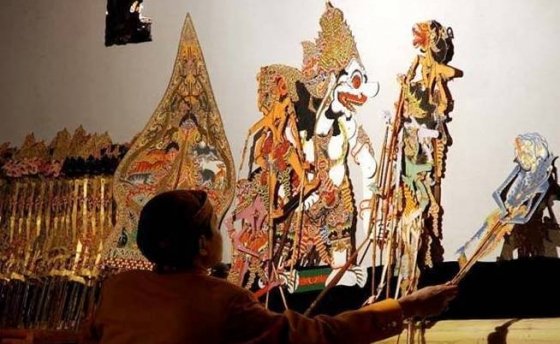Wayang kulit is one of the arts tradition that grow and develop in Java society. More than just a show, wayang kulit was used as a medium for reflection toward the spiritual spirit of the gods. It is said that "wayang" comes from the word "ma Hyang", which means toward the spirituality of the power. But, there are also people who say "wayang" comes from a performance technique that relies on shadow (shadow / puppet) on the screen.
Wayang kulit is believed to be the embryo of various types of puppets that exist today. This type of puppet is made of dried buffalo leather sheets. In order for the motion of the puppets to be dynamic, on the right side of the body is connected using a screw made of buffalo horn.
Wayang kulit is played directly by the narrator called puppeteer. The puppeteer can not be played by just anyone. In addition to must be good at playing puppets, the puppeteers also have to know various epic story puppets like Mahabrata and Ramayana. Dalang used to be considered a noble profession, because the man who is the puppeteer is usually a respected, knowledgeable, and polite man of character.
While playing the puppets, the dalang accompanied the music that comes from gamelan instruments. On the sidelines of the sound of gamelan, chanted Javanese verse sung sung by the pesinden who generally are women. As a magical tradition of art, offerings or offerings are mandatory elements in every wayang performance.
Sesajian in the form of chicken, coffee, rice cone, and other crops, and do not forget the smoke from burning incense is always there in every puppet show. But, because many who consider the offerings is a waste, lately offerings in puppet performances are also intended for the audience in the form of eating together.
Wayang kulit is a wealth of archipelago that was born from indigenous culture of Indonesian people who love art. Every part of the puppet show has strong symbols and philosophical meanings. Moreover, in terms of content, puppet stories always teach noble minds, love each other and respect, while sometimes inserted social criticism and funny role through the scene goro-goro. It is not wrong if UNESCO recognizes it as a legacy of Indonesia's cultural treasures worthy of dignity.

Hi! I am a robot. I just upvoted you! I found similar content that readers might be interested in:
https://visitkhatulistiwa.com/javanese-culture-the-art-of-wayang-kulit/